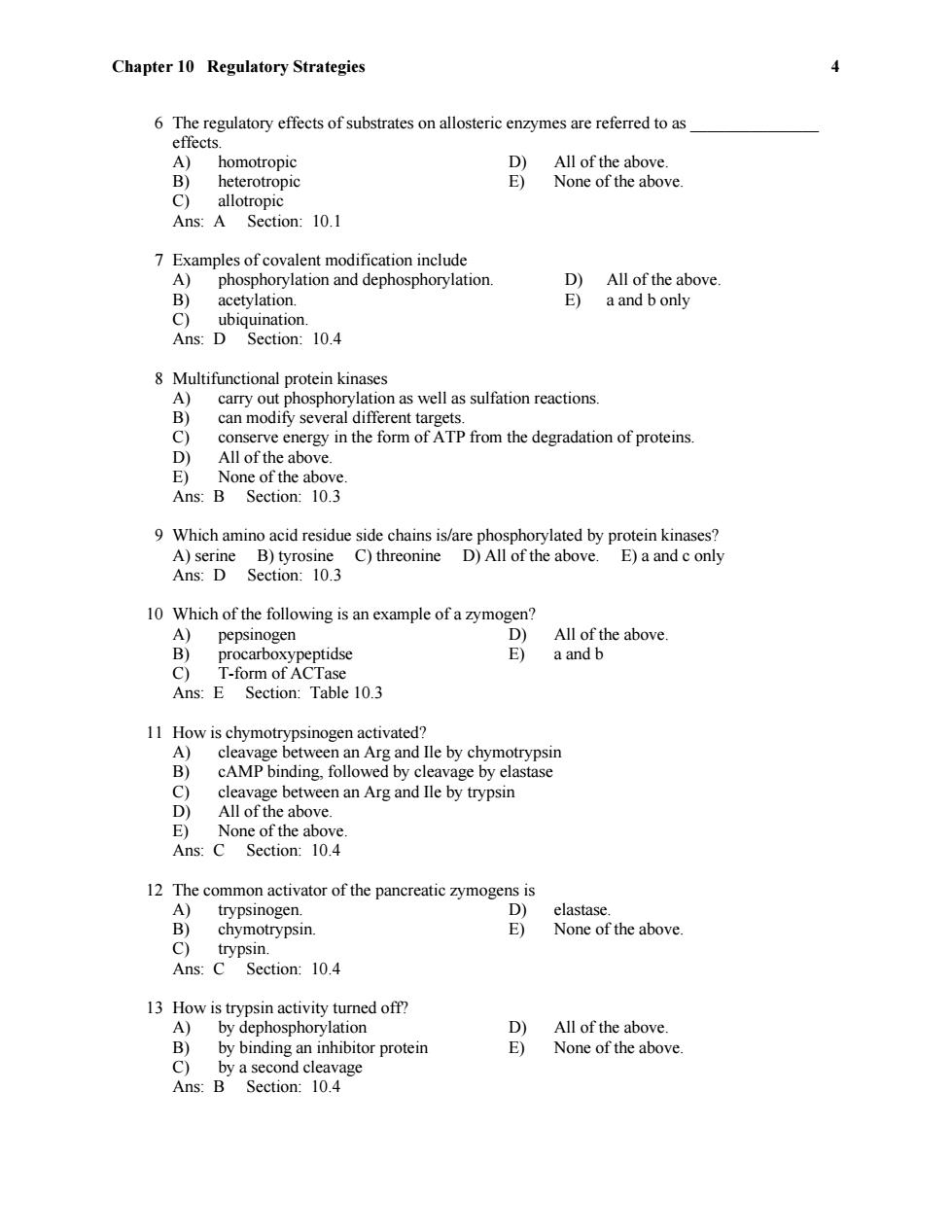正在加载图片...

Chapter 10 Regulatory Strategies 4 6 The regulatory effects of substrates on allosteric enzymes are referred to as effects. A) homotropic D) All of the above. B) heterotropic E) None of the above. C) allotropic Ans:A Section:10.1 7 Examples of covalent modification include A) phosphorylation and dephosphorylation. D) All of the above. B) acetylation. E) a and b only C) ubiquination Ans:D Section:10.4 8 Multifunctional protein kinases A) carry out phosphorylation as well as sulfation reactions B) can modify several different targets. C) conserve energy in the form of ATP from the degradation of proteins. D) All of the above. E) None of the above. Ans:B Section:10.3 9 Which amino acid residue side chains is/are phosphorylated by protein kinases? A)serine B)tyrosine C)threonine D)All of the above.E)a and c only Ans:D Section:10.3 10 Which of the following is an example of a zymogen? A) pepsinogen D All of the above. B) procarboxypeptidse E) a and b C) T-form of ACTase Ans:E Section:Table 103 11 How is chymotrypsinogen activated? A) cleavage between an Arg and Ile by chymotrypsin B) cAMP binding,followed by cleavage by elastase C) cleavage between an Arg and Ile by trypsin D) All of the above. E) None of the above. Ans:C Section:10.4 12 The common activator of the pancreatic zymogens is A)trypsinogen. D) elastase B) chymotrypsin E) None of the above. C) trypsin Ans:C Section:10.4 13 How is trypsin activity turned off? A)by dephosphorylation D All of the above. B)by binding an inhibitor protein E) None of the above C)by a second cleavage Ans:B Section:10.4Chapter 10 Regulatory Strategies 4 6 The regulatory effects of substrates on allosteric enzymes are referred to as _______________ effects. A) homotropic D) All of the above. B) heterotropic E) None of the above. C) allotropic Ans: A Section: 10.1 7 Examples of covalent modification include A) phosphorylation and dephosphorylation. D) All of the above. B) acetylation. E) a and b only C) ubiquination. Ans: D Section: 10.4 8 Multifunctional protein kinases A) carry out phosphorylation as well as sulfation reactions. B) can modify several different targets. C) conserve energy in the form of ATP from the degradation of proteins. D) All of the above. E) None of the above. Ans: B Section: 10.3 9 Which amino acid residue side chains is/are phosphorylated by protein kinases? A) serine B) tyrosine C) threonine D) All of the above. E) a and c only Ans: D Section: 10.3 10 Which of the following is an example of a zymogen? A) pepsinogen D) All of the above. B) procarboxypeptidse E) a and b C) T-form of ACTase Ans: E Section: Table 10.3 11 How is chymotrypsinogen activated? A) cleavage between an Arg and Ile by chymotrypsin B) cAMP binding, followed by cleavage by elastase C) cleavage between an Arg and Ile by trypsin D) All of the above. E) None of the above. Ans: C Section: 10.4 12 The common activator of the pancreatic zymogens is A) trypsinogen. D) elastase. B) chymotrypsin. E) None of the above. C) trypsin. Ans: C Section: 10.4 13 How is trypsin activity turned off? A) by dephosphorylation D) All of the above. B) by binding an inhibitor protein E) None of the above. C) by a second cleavage Ans: B Section: 10.4